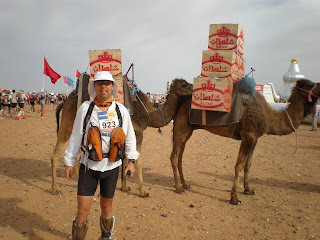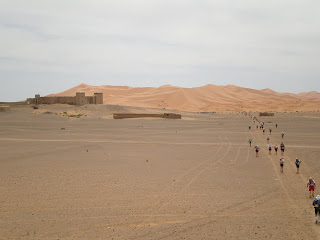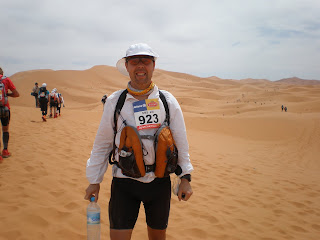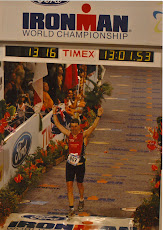People have asked did I enjoy the MdS. Well the answer is pretty easy.
The EVENT was wonderful. The people I met were all amazing achievers with such a great attitude to life. The scenery was fantastic. The event was well organised and the food (in towns, not so much the cold freeze dried food I had) was terrific.
The RACE though was not so much fun. Having done Comrades, 18 ironman triathlons and a few straight marathons, I didn't even really consider not finishing was an option. But on day 1 my feet began blistering and they got worse and worse until they got to the stage when I couldn't hardly walk, but could trot, so I managed to keep going until the point when I actually couldnt walk. So I made it to part way into Day 6, did about 202km, and my feet hurt for the last 170km.
Two weeks later, the feet look absolutely atrocious, with healing blisters and dead skin everywhere, but I can walk normally again, and there is no long term damage. The anti-biotics healed the infection, so all is nearly good in the world :)
And with that introduction, let me share the photos I took of the event with you.
PRE EVENT
After 36 hours of flying time from Melbourne to Ouarzarzate (pronounced Waah-zar-zat), which included a horrible 8 hour layover at Casablanca airport for a 40 minute flight, it was nice to turn up at the pre race hotel.
Entering, it looked a little like the Faulty Towers hotel from the tv show, with letters not quite right on the entrance, but the staff were nice and friendly, and there were no Spanish waiters!

Nice view down to the pool from my rooftop "penthouse" room

My penthouse room which was a great size and very comfortable.

Before we headed out to the desert, Jay Batchen gave the group a briefing and tips on how we could save weight and some tips on packing the gear.

As a result of that, I repacked all my food, took them all out of their original packaging and out them into ziplock bags. It saved a fair bit of space, but probably not a lot of weight. Here is my gear for the week...the only thing the organisers provide is a berber-style tent and water.

On our last night pre departure to the desert, Wayne and I headed into town. Quick look around, some emailing, and a couple of night-time photos in the main town square.


HEADING TO THE DESERT
Finally it was time to head off to the desert. Excitement was high as we boarded the bus

The course has been a closely guarded secret. As we travel to the desert the road books are handed out and we can finally have a look at the course. The days are 33km, 38km, 38km, 82km for the long stage, then 42.2km and finally 17.5km, for a total of 250.7km, the longest of the 26 years of the Marathon des Sables.

Some views on the 370km bus ride to the start of the race! Yes, it puts it all in context when they drive you that far to the start!


Lunch was just on the side of the road, the buses just pulled over and we all just ate on the ground. There are no luxeries in the MDS!

Soccer is clearly the world game, but this is a tough surface to play on!

The buses could only take us so far. The terrain was too rough for the buses for the last 2km, and we got loaded onto army trucks.

The ride to the bivouac was absolutely brutal. At times your backside jumped nearly a foot in the air... no wonder that the buses stopped where they did!
Eventually I made it to our tent, tent 113. There were around 120 tents, arranged in a large circle, with two rows of tents around the circle. The tents provided some protection, but being open on two sides, not so much!



Sunset on the first night at the bivouac


For the first two nights at camp, the organisers fed us, and we even got some beer and wine! Although again no luxeries, we were sitting on mats on the ground.

For someone who can never get up early normally, you'll be surprised to know I was up before the sunrise on most days! No alarm clock needed here!


Ah so let's talk about the toilets. In previous years, there were none. Yep, you just found some ground and did your thing. This year, there were cubicles of sorts.
We even had someone come around to explain how to go. First there was a seat, and then you had to put what is best described as a bin liner over the seat. Do your business, tie it up and put it in a bin outside the cubicles. OK, so its not the most hygenic approach, but its a whole lot better than just going on the ground!!

As you can imagine, the bin-liners for use in the loo had many names. Being the classy tent, we voted "crap sack" as the most appropriate. Here is me going with mine for the first time!

The event was sponsored by Sultan tea, and we had camels carrying crates of tea throughout the event.


The administration checks on how much food you had, were you carrying all the required compulsory equipment, was done in numerical order. As number 923, I was right near the end of the line. The down side was I had to wait most of the day before it was my turn, the upside was that the checks were fairly limited and I was in and out in 15 mins, while others queue'd for over an hour earlier in the day.
Getting my race numbers and emergency flare

Passed the medical checks with the happy doctors!


Late in the day there was the race briefing by Patrick Bauer. We found out some statistics about the event:
- 849 starters, including 130 females
- 43 countries are represented on the start line, so its certainly a global event
- the oldest competitor, a man at 79 years of age
And we had a minutes silence for the Japanese earthquake and tsunami, as a number of past competitors come from that area, and some from this year decided not to come as a result of the disaster.
I knew I also had lots of people supporting me, both at home, and from various running websites and friends far away. I was particularly touched by the best wishes of a group of school girls, who knew of me via a running friend of mine Monica, who went to the trouble of even making a sign for me at school. How wonderful is that! That you so much Monica, Hannah and the rest of the girls.

Going to bed on the night before the race started, I just thought how lucky I was to be here, and what a great experience this was... already.
PRE RACE DAY 1
Day 1 was a 33km stage, the highlight of which was 13km through the Erg Chebbi sand dunes. Cut off for the day was 10 hours.
Sleeping overnight was not so easy. The ground was hard, and the rug and sleeping mat didnt seem to soften anything up too easily. I was awake before the dawn, but it is cold overnight, so you stay in your sleeping bag for as long as you can.
Instead of roosters or an alarm clock to wake you up, you get woken up by the calls of the camels before dawn!!
We were lucky with the weather though, sunny and not too hot.
Sunrise at tent 113.

At 7am the berbers arrive to come and take the tent down. On day 1, we tried to do the nice thing and get out of the tent before they took it down.

Cathy just made it out in time! Mind you, it does only take them 40 seconds to take the tent down!



Nothing like a good breakfast of cold porridge to get you ready for the day!

We had a few hours of preparation to go, certainly enough time for a group photo of tent 113. In order from left to right, the group is me, Todd, Mike, Cathy, Ed, Brian, Jason and Wayne.

The people in your tent are really important to the quality of the experience you will have. You are in the desert, living in very close quarters with these people for 9 nights, so its important that you get along and enjoy each others company. I was lucky to have struck a terrific group, all great people, all willing to help each other out, and despite a few nights interupted by some snoring... it was a terrific group of people. In their own way, each one of them might my week a little better by them being in tent 113.
Finally after waiting around for a couple of hours, it was time to wander down to the start line.

This looked like a good photo opportunity! And I am still relatively clean and clean shaven at this stage of the event.

And then it was time to line up for the traditional group photo of all competitors, making the image of the number of the event. As this year was the 26th year of the event, we were all lined up in the number 26!
This is what it looked like from the ground looking up at the helicopter

And this is what it looked like from up in the helicopter

Then we moved over to the start line and it was very exciting. 849 competitors, some camels...

and everyone with their cameras out taking photos at the start line. It was an electric atmosphere!

And then the music started, first Stand By Me and then Highway to Hell and the crowd was rocking, from Patrick Bauer and his interpreter on the top of the Landcruiser

to the Spanish girls who were dancing up a storm right next to us in the starting area

And finally, after a countdown from 5 to 1 (in French), Patrick points his arm out into the desert, and the 26th Marathon des Sables is on.

DAY 1. 33km. 10 hour Cut Off.
The start was manic. People rushing everywhere, camera crews everywhere, helicopters buzzing low in the sky... It was great to see my mate Wayne with his Aussie flag just after the start

I was conscious that its a long event, that I had 12kgs in the backpack (including water) so I was happy just to stroll along and take photos of the crowd early on. And within 200m we were already into soft sand.

The helicopter flies in low, sideways, allowing the onboard cameramen to take photos of the event. From a competitors point of view, seeing the helicopter whip in low and sideways was simply awesome.

And you could never get lost... just follow the footprints in the sand!

Not long after the start, an Italian guy stood on the back of my shoe and took the shoe off my foot. Given there was sand dunes on every day of the event, I was a bit worried that he had ripped my gaiters which would have let sand in the shoes. Happily that wasn't the case, but by the time I had myself sorted out, the "sag camels" who follow the race, had caught me! Time to get a move on!!

In what might be a surprise to many, the Sahara Desert is not just full of sand and sand dunes. In fact it is probably mostly rocky, which is not so great for the feet. We usually can follow some car tracks to get a better flat surface, but if you need to pass someone, its onto the stones.


No privacy in the desert, if you need to go, you just go.

Despite being in the middle of no where, we even had some spectators out on the course!!

A little village right near checkpoint 1, and on the edge of the famous Erg Chebbi sand dunes.

Am not sure who has right of way in the desert.. runners or camels?

Arriving at checkpoint 1, 13km completed. The checkpoints were a sea of 4WD vehicles and volunteers handing out your water rations. There were also doctors at every checkpoint to treat any medical issue.


And with that, it was off for one of the highlights of the entire event, 13km through the Erg Chebbi sand-dunes! The jury was out whether it was good to be doing this early (when you're fresh and feeling good) or bad (doing it with the heaviest weight on your back and when you haven't yet got your desert legs). But the leaning from most people who had done it before, was that it would have been better to do this later in the event...

The dunes are often described as a sea of sand - big waves out here!

Its kind of amazing that you can see where the dunes actually start, and the stony ground ends

Its early in the event and the excitement was still very high


There were some amazing people that I met during this event. In fact, it was the people that I met during the event that were the highlight of the entire experience. This guy, Daithi from Ireland, was one who stood out beyond all others. When you look up "nutter" in the dictionery, this man is there! He has just come back from running 400 miles in the arctic and setting a world record, now he is doing this event in the Sahara, then he is off to Nepal to run a marathon up from Base Camp and then another back down again. After that, he is working on an across Antarctica trek. Simply amazing.

Walking up the dunes is just like walking up stairs - if you can stay in the footsteps of the person in front of you! The sand is incredibly fine and gaiters are essential to keep sand out of your shoes.

Its actually a very pretty place

I spent a lot of time out in the desert with Andrea. Great girl, amazing life from Czrech Republic, time in New York and Dubai - just an amazing person.

Now something that is totally amazing, there was a blind runner and guide doing the event. And they were pretty quick too, I only caught up with them right at the very end of the dunes.

Out of the dunes then there was a 7km stretch of stones back to camp. And it was into a brutal head wind.

Finally, the finish line arrived and stage 1 was completed. The 33km took me 7 hours 14 minutes, and my heart rate hit 167 (90% of maximum) trekking through the sand dunes.
My feet got really sore on the last half of the 7km stony stretch, and while they dont look so horrible in the photo, the blisters were starting.

I wasn't really sure what to do about the feet. They had been sore for the last 3kms of the day and I took some advice from one of our fellow participants, Janet. I figured she had good advice to give, since she had to pull out last year when her feet blistered so badly, when all the blisters joined up and finally punctured, the whole bottom of her foot effectively fell off! Her advice was to see the doctors early, rather than risk something like what happened to her last year to happen to me.
So with some trepidation, I visited the Doc Trotters (volunteer doctors). English was only a minor problem, Frence is the main language of the event. I found that the treatment is to initially wash your feet in disinfectant outside the medical tent.

Inside the tent, the practice is to cut open the blister (which can hurt if its not a fully formed blister) and put iodine in the wound to dry it out (which also hurts) and then they bandage up the wound. So you are kind of running on an open cut.

After I was patched up by the doctors, it was cold freeze dried food for dinner. Not the nicest meal I have ever had, but enough calories to give me enough energy to get through tomorrow.
So day 1 was down. Over 7 hours out on the course, and a fairly brutal but magical day. I knew that the only reason I wouldnt finish the event is if my feet had problems, and having blisters on day 1 and the feet now being cut open by the doctors, I guessed it was 50/50 whether I would finish or not.
Still, I knew all you could do is live in the moment, and prepare for day 2. So that's what I did. Early to bed, but the wind was blowing sand everywhere, so wasn't sure it would be a good nights sleep.

No comments:
Post a Comment